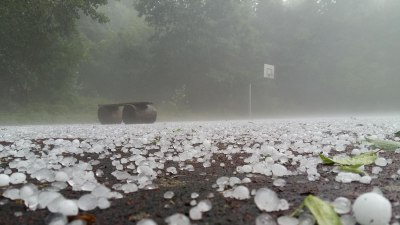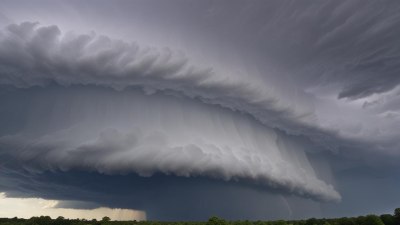The Science of Hailstorms and Why They Are Getting Bigger
Explore the science behind hailstorms and discover why their size is increasing due to climate change.

Hailstorms are fascinating meteorological phenomena that can result in significant damage to property, crops, and infrastructure. Understanding hailstorms requires delving into their formation, characteristics, and the factors that contribute to their growing intensity. In recent years, scientists have observed a trend indicating that hailstones are becoming larger and more frequent. This article aims to explore the science behind hailstorms, their cyclical nature, and the environmental changes prompting their increased severity.
What Are Hailstorms?
Hailstorms occur during thunderstorms when updrafts of air carry water droplets into extremely cold areas of the atmosphere. These droplets freeze and form hailstones, which can vary significantly in size from tiny pellets to large golf ball-sized chunks or even larger. The process of hail formation begins in the cumulonimbus clouds associated with severe thunderstorms, where updrafts are strong enough to lift water droplets above the freezing level.
The Formation Process
The steps of hailstorm formation can be outlined in several phases. Initially, strong updrafts lift water vapor and airborne particles into the atmosphere. As the temperature decreases with altitude, these droplets freeze into small ice particles. Once formed, they may be carried upward and downward within the cloud by turbulent air currents, accumulating additional layers of ice with each pass through the supercooled water regions.
When hailstones grow heavy enough to overcome the updrafts, they fall to the ground, potentially damaging everything in their path. The size of the hailstones correlates with the strength of the updrafts and the duration of their travel within the storm; stronger updrafts can hold hailstones in the cloud longer, allowing them to grow larger.
Factors Influencing Hail Size and Frequency
Several meteorological and climatic factors contribute to the frequency and size of hailstorms. One of the most significant factors is the temperature. Warmer temperatures lead to increased moisture in the atmosphere, providing more fuel for storm formation. Additionally, the intensity of thunderstorms has been linked to elevated temperatures; hence, the increased occurrence of extreme weather conditions could result in more frequent and larger hailstorms.
Another critical element is atmospheric instability. Highly unstable air masses, characterized by warm surface temperatures coupled with cold air aloft, provide optimal conditions for hailstorms. This instability can be exacerbated by climate change, as global warming patterns lead to rising temperatures and altered precipitation patterns.
The Role of Climate Change
Climate change plays a pivotal role in shaping weather patterns, including hailstorms. Rising global temperatures affect the intensity and frequency of severe weather events. Studies indicate that with each degree Celsius increase in temperature, the atmosphere holds about 7% more moisture, essentially increasing the potential for more severe thunderstorms capable of producing larger hail.
Furthermore, as the climate warms, the conducive conditions for hailstorm creation become more prevalent. This results in enhanced storm development and more instances of extreme weather, including hailstorms that can unleash hailstones several inches in diameter, creating a more destructive impact on communities.
Regional Variations
Hailstorms occur in various regions worldwide, with certain areas, such as the Great Plains of the United States, experiencing particularly high frequencies. Geographical features such as mountains, valleys, and broad plains contribute to the occurrence and size of hailstorms. The U.S. Southeast and Midwest, for example, have a high incidence of hail because they encounter the right combination of warm moist air and cool dry air, setting the stage for intense thunderstorms.
In recent years, scientists have noted not just an increase in the frequency of hailstorms but also a larger average size of hailstones. This has led to increasing concern about the economic ramifications, as the costs associated with property damage and agricultural losses are rising dramatically. Crop losses from substantial hailstorms hit farmers hard, resulting in diminished yields and substantial financial loss.
Technology and Research
Advancements in meteorological technology have allowed researchers to better understand and predict hailstorm activity. Doppler radar systems can track the movement of storms and the intensity of updrafts, helping meteorologists issue timely warnings to communities in potential paths of hailstorms.
Additionally, satellite technology allows for the observation of larger weather patterns contributing to hailstorm development. By utilizing these tools, scientists can assess changing climatic conditions over time and predict future trends in hailstorm frequency and severity.
Preparing for Hailstorms
Given the increasing incidence and intensity of hailstorms, preparation is crucial for individuals and communities. Homeowners should consider investing in hail-resistant materials for roofs and vehicles to mitigate damage. Furthermore, awareness campaigns can help educate the public on recognizing signs of severe weather and the actions required to minimize risks during a hailstorm.
Farmers can implement preventative measures such as hail nets, which can reduce damage to crops and ensure yields remain viable. Ultimately, understanding hailstorms is integral to preparing for and mitigating the economic losses associated with these increasingly common weather events.
The science of hailstorms encompasses a range of meteorological factors that interplay to influence their formation, size, and frequency. As climate change progresses, the patterns governing these severe weather events become increasingly pronounced, leading to larger hailstones and more destructive storms. Armed with knowledge and preparation strategies, individuals and communities can resiliently weather these challenging storms. The continued study of hailstorms not only enriches our understanding of these phenomena but also provides critical insights that can guide future climate resilience and adaptation efforts.











